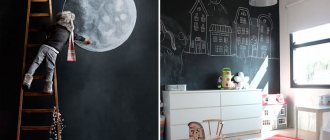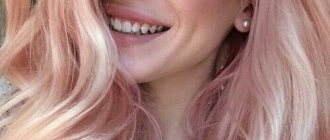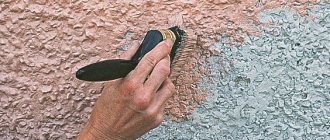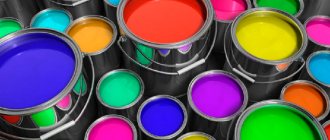Hello, dear readers of the KtoNaNovenkogo.ru blog. Brown is not the brightest color, but it is one of the most popular.
It is necessary when you need to draw the ground, tree trunks and branches, ancient ships, houses, furniture and much more.
It is also widely used in the renovation and design of various premises. Lastly, brown hair dye is also quite popular.
But what if you don't have brown in your palette? Or is there, but not at all the shade you need?
The answer is simple - you need to get the desired brown by mixing other colors. But we will tell you exactly which ones and in what proportions in this article.
How to get classic brown
One of the main and easiest ways to make brown is to mix green and red dye. These colors are available in any palette of paints, from construction paints to those intended for painting on paper canvas. The use of dark green and dark red is not permissible, otherwise we will get a color close to black, but not dark brown.
The next method is to mix 3 dyes: red, blue and yellow. This method follows from the previous one; instead of green, we use blue and yellow, which when mixed give green, and as a result we get the color formula described above. This combination of colors is good when the palette runs out of green.
Another way to make brown is to mix orange and gray or orange and blue, which is more appropriate for a regular paint palette.
The last way to get classic brown is to combine purple and yellow paints. Instead of magenta, you can use violet. This option is less popular because it is difficult to control the resulting color when mixing, the slightest overdose and the shade is no longer the same.
Methods for producing brown flowers
Features of color and its shades
In nature, brown is obtained as a result of the solidification of liquids of yellow shades. Because of this, it is sometimes called dark yellow. The similarity to mixed colors, such as bronze, chestnut and coffee, is explained by the large number of different pigments in their composition. In fashion, brown has always been contrasted with bright, rich tones, and therefore has received a reputation for being “grown-up and respectable.” This color scheme also includes many shades. They got their names due to the prevalence of brown in nature and everyday life. These include wheat, brown, rust, copper, dark beige, brown, chocolate, as well as khaki, sepia and the color of withered leaves. Some tones have a peculiar tint. Dark burgundy is also considered a shade of brown, but this does not apply to burgundy in general, which in principle is not mixed, but is close directly to red.
Making shades of brown
A traditional palette is good, but its use is not always required, for example, when painting a wall in a hallway, a lighter tone would be more appropriate, but to give a picture realistic colors when depicting the earth, dark paint is usually used. Below are instructions on how to make brown darker or lighter:
- How to get dark brown color? Let's not reinvent the wheel and propose the most effective method - adding a black component. We recommend mixing in small drops, otherwise you risk ruining the resulting paint and will have to throw it away. After adding a small dose of black, mix thoroughly until the consistency is homogeneous, only then decide whether you need to darken it further.
- How to get light brown color? Here we will also follow the well-known path and propose a method for using white or white dyes. Adding brightening colors can be done more intensely than darkening ones. This is due to the fact that if you lighten the brown too much, you can always go back a couple of shades darker. The main white paint is white paint, in addition to it you can use yellow - which will give an ocher tint, red - will give shades of rust, and blue will make it deeper and more contrasting.
For art lovers, together with Olga Bazanova, we have prepared a video lesson on mixing brown from other colors:
What paints to use
Different types of paints have their own characteristics. To obtain shades of brown, gouache and acrylic are used.
Acrylic paints
Acrylic is a universal material. They paint pictures and paint stained glass windows. It is convenient to work with rich colors: to do this, it is enough to purchase paints of 7 colors. If necessary, they can be mixed to obtain the missing shades.
When you combine yellow with brown and black, you get the color of avocado. To create a reddish-chestnut color, combine brown with red and add black. The chestnut tone is created by a mixture of red and yellow. A little white and black is added to the resulting composition. When painting with newly obtained compositions, you should remember that the dried canvas has a different appearance compared to the wet coating.
Gouache paints
Beginning artists often start working with gouache. The paint is thick, with bright colors, easy to apply to paper, and dries quickly. In stores you can always buy a ready-made set, which includes basic tones, but they are sometimes not enough. In this case, they resort to mixing, checking the color wheel. When combining paints, we must not forget that gouache becomes lighter when it dries. Black color is added carefully, in small portions. Too much white makes the shade look cold.
To get a brown tone, you need to mix 2-3 shades.
Pros and cons of mixing brown
As strange as it may sound, making your own brown paint is not always the best idea. Let's look at when it is profitable to mix, and when it is better to buy ready-made dye:
- You paint with acrylic paints on canvas - here you can make brown and its shades in any quantities and portions of colors;
- You are making repairs and there are excess paints left from which you can get brown for use in the intended design;
- You do whatever you want, but the color palette presented in stores doesn’t contain what you need;
- If the design of the room includes brown walls, then you should not buy other colors to mix them; there are enough brown paints in hardware stores to choose the right one;
- If you dye your hair, you should not mix different components, even of the same shade, unless this is provided in the instructions;
- If you are not sure in advance that you will use brown.
Shades of brown
Mixing Rules
Even black is the result of combining primary colors in a certain proportion. It is added to darkening formulations. White is neutral; it can be used to lighten paint or gouache.
Before you figure out what colors to mix to get brown, it's important to understand some color combination principles:
- There are two types of tones, chromatic (colored) and achromatic; the latter include white (neutral), gray and black; they are distinguished only by saturation, lightness and tone;
- according to the rules of color, all shades are placed along the color wheel; if you mix two adjacent colors, you will get an intermediate tone, which in this circle will be located exactly between them;
- when combining opposite colors, achromatic ones are obtained;
- You can change the shade by combining proportions;
- paints are connected to each other both mechanically (using banal mixing) and by applying a stroke on top of the previous one (the so-called optical method).
These rules apply to any composition: oil, alkyd, art, acrylic paints or gouache. It is better to combine them in white dishes - this way the result will be better visible.
Secrets of mixing colors
- To make beautiful brown paint, use precise proportions.
- If you achieve the desired tone, then add the “thinner” color a little at a time, otherwise you risk ruining everything.
- Try to test the resulting dye on a small area to be painted, because the color in the jar and on the surface may differ.
- When working with a painting, you can combine paints directly on the canvas, thereby achieving an interesting effect.
- Before combining other paints, read the instructions; the color of the dried paint may differ from the one applied, this should be taken into account.
Rules for mixing colors
Colorism and obtaining a certain color from others is a science based on the color wheel. There are only 3 primary colors: yellow, blue and red. The rest can be made by mixing them together and are called secondary (purple, orange and green). Therefore, before answering questions about how to get brown paint, what primary or other colors are needed, you need to understand the rules for mixing colors.
Basic laws of mixing:
1. One color in a circle is a symbiosis of tones opposite to it relative to the center, the resulting additional tone is called achromatic. There are also complementary colors. For example, red is opposite green, yellow is opposite blue.
2. When paints adjacent to each other in a circle are mixed, new ones appear. So, to get orange, you combine red with yellow; green paint is obtained by mixing yellow with blue.
3. When the same shades are combined, similar mixtures can be obtained.
Advantages of mixing and problematic issues
Deciding to make your own brown by mixing is not always considered the best option. In what cases will brown paint made at home help you achieve your goals and when is it better to avoid experiments by purchasing a ready-made color? Let’s consider in detail:
- The creative process of painting on canvas with acrylic compounds is an ideal field for experimenting with mixing in different proportions and obtaining all kinds of shades.
- When during the renovation process there are suitable jars with unused color, and brown is exactly what is required in the design, please be inspired to search for the right tone.
- If any household need to paint a surface brown is accompanied by a lack of the necessary paint in the store.
- The renovation is in the planning stage, does the interior design include brown? You should not initially purchase various components for mixing; choosing a ready-made color scheme from a wide range of hardware stores will be the optimal solution.
Ways to get classic color
The answer to the question of how to make a classic brown shade depends on the paints available. There are several mixing options:
- By combining red and green dye. Moreover, the use of dark red and dark green shades is unacceptable, otherwise a background close to black will be formed.
- If the existing paints do not contain a green element, mix blue with yellow and add red.
- Brown paint can be obtained by adding a gray or blue tint to the orange color.
- Those who want to experiment can be advised to mix yellow and purple colors. A violet tone is sometimes used as a substitute for purple.
How to get a dark brown color when mixing paints and gouache?
If we talk about previous mixing options, more blue or green will make a darker brown. But they will also add their own nuance. There is another, simpler and faster way to get a dark brown color.
- Just add black paint . But you need to work with it extremely carefully, since a small dose of excess paint will simply turn it into black.
- Therefore, add paint in tiny portions and take note of one rule - conduct experiments with a small amount of paint.
Mixing colors
- By the way, in order not to make a mistake with the desired color, mix a little black with white. But leave the dominance of the first shade. Just make it a little softer as it can quickly eat up the brown color.
Receiving process
To get the orange color by combining shades on paper, you first need to decide what you want to get in the end. Because if you apply yellow on top of red, the resulting tone will be darker than if you apply red on top
It is also important to ensure that the mixing brush is clear of any extraneous shades, because... the presence of paint of a different color on the brush hairs can give a completely unexpected result. The same rule must be followed if you are planning to get the required orange color in dry painting
Just apply layers of red and yellow on top of each other and then rub together. The resulting shade will entirely depend on what color layer was applied on top: if the last layer was yellow, then the orange will be lighter, if red, a red-orange tone will be formed.
We recommend watching a video about mixing:
When mixing paints on a palette, the situation is somewhat simpler. You need to apply a little of one base paint and another to it, and then mix with a palette knife (a special small spatula). A regular brush will work, but again, make sure the brush is free of other paints.
Completely different mixing rules must be followed if you work with oil paints. To make the final color orange, you need to apply the yellow and red strokes very close to each other, then when you move a little distance away, you will see that you have achieved the desired effect.
How to work with a palette correctly
The color range is created using:
- basic coloring compositions;
- palettes for combining substances;
- glasses of water;
- brushes
White is placed in the center of the palette, and the remaining compartments are filled with selected dyes. Mixing is carried out carefully, introducing the color in small volumes. Brushes are washed after each mixing. Strokes applied to the test surface help evaluate the result.
Beginning artists may have a question about how to get brown color, because it is not always found in a gouache set. This tone is not included in the group of basic ones and can be obtained from a mixture of the latter. But the wrong approach to combining paints often leads to a gray mass or the wrong shade that was originally required. To create paint that is no different from store-bought paint, you need to know the tricks of coloring.
Using different colors
It is necessary to take brown as a base and gradually add white in small parts. For a brighter result, you can add a little yellow. Similar manipulations are also relevant for watercolors, if such a need arises.
How to make beige from watercolor: mix yellow, white and pink. Each of them must be diluted in small portions, carefully observing the result so as not to spoil it. In some situations, diluting brown will be appropriate. If the tone consists of a large number and volume of additives, then it may not be very suitable for work.
To obtain the required shade from acrylic paints, you must follow this scheme:
add a small amount of brown to white paint; everything is thoroughly mixed; orange paint is carefully mixed in (it is acceptable to replace it with a combination of yellow and red); Everything is thoroughly mixed again.
Light brown tones
Adding a white color will help make the brown color lighter. There are other popular light shades. For example, a brown tone with copper, gray or honey nuances, coffee and milk - these shades can be used if you add white paint in different proportions.
The addition of yellow makes the color ocher, and tobacco is obtained by mixing 4 colors: yellow, green, red and white.
Henna and cocoa color. How to get chocolate hair color using henna and basma
Women are fickle natures. Today we want to be a red-haired beast, and tomorrow a chocolate beauty. And what after tomorrow?.. Periodically, once a year, I am visited by the desire to get a brown (dark chestnut or chocolate) shade of hair. And then I buy a package of basma for henna. This time I came across Indian henna and Indian basma Phytocosmetic.
Since I have been dyeing my hair with henna for almost 4 years, the pigment is quite firmly attached to my hair. Usually my mother does my makeup, but... this time for some reason I decided that I could handle it myself. I shouldn’t have decided so. A little about my hair: moderately thin, not thick, short, not damaged. My hair is naturally light brown, wavy, and of normal type. The scalp is prone to dryness and flaking. For some time now I have decided that I am tired of growing my hair long and that I am more comfortable with short hair. And I asked my husband to cut my hair. (It was in the evening, there was nothing to do...) Next time I plan to go to the salon and trust a professional. Now let's take a closer look at the henna and basma that I bought.
Henna Indian Natural Phytocosmetics.
Volume: 125 g Price: 85 rub. Packaging: cardboard box, inside of which there are 2 foil bags with henna.
Texture: finely ground powder, yellowish-greenish in color.
Basma Indian Natural Phytocosmetics.
Volume: 125 g Price: 95 rub. Packaging: cardboard box, inside 2 foil bags with basma.
Texture: finely ground powder, light green in color.
Application of henna and basma: Stage 1 - I take 2 spoons of henna and 2 spoons of basma, pour them into a plastic container. I fill it with hot water (90 degrees). Usually 200 ml of water is enough for me. I stir thoroughly so that there are no lumps left.
Stage 2 - add 1 teaspoon of oil to the finished mixture (in this case I have peach oil).
Stage 3 - while the coloring mixture is cooling, I go wash my hair with shampoo, without using conditioner. Stage 4 - let's start painting. Henna was applied with a brush, strand by strand. Girls who dye their hair themselves, you are my heroines!!! It turns out it's so difficult. I’m used to sitting relaxed and not straining when my mother paints me. And then I had to do everything myself... I stained everything with henna (both the bath and myself). And considering that I am myopic, this is a feat on my part. Blind painting. I did it! I dyed my hair! She put a plastic bag on her head and went to do household chores.
After 2 hours, I washed off the henna with warm running water. Apply a generous amount of conditioner to all hair, including the roots. Massaged it and washed it off. And this is what I got.
I'm happy with the result! But next time I will resort to the help of my mother. That's all! Goodbye! I wish everyone gorgeous hair!
Mixing acrylic-based materials
Designers love acrylic paints the most. They are very easy to work with, and the finished coating has excellent water-repellent properties. Their use has several nuances:
The working surface must be perfectly flat and smooth
To do this, it needs to be sanded. It is important that the paint does not dry out. To obtain an opaque color, use undiluted paint. Conversely, you can add a little water for transparency. To be able to quickly select the desired color, it is recommended to use a thinner for acrylic paints
Thanks to it, the product will not dry out so quickly. Use the edge of the brush to distribute the paint. Mixing is best done with a clean instrument. In this case, the colors should be directed towards each other. To make a light tone, you need to add white dye to the solution, and to get a dark one, add black. It is worth remembering that the palette of dark colors is much wider than light ones.
Here are some examples of mixing acrylic-based paints:
- Apricot color is obtained by mixing red, yellow, brown and white.
- The recipe for making beige paint involves combining brown and white. If you want a bright beige, you can add a little yellow. For a light beige shade you will need more white.
- Gold is the result of mixing yellow and red colors.
- Ocher is yellow and brown. By the way, it is considered popular this season.
- Khaki can be made by mixing green dye with brown.
- To get purple you need three different colors: red, yellow and blue.
Tips and tricks
Artists advise buying ready-made brown if you have doubts about the quality of mixing paints with your own hands. For example, when working with acrylic, problems may arise when applied to canvas or clothing - the color on the canvas will look different depending on the manufacturer and the specific components in the composition.
It is also better to carry out tinting in a store if you have to paint a large volume of walls in the house - it is almost impossible to get a second portion of exactly the same paint without special equipment. In other situations, don’t be afraid to experiment and create new colors yourself - this will allow you to express your imagination to the fullest!
Five ways
Note. So, we already understand from which paints to get brown, but besides this, there are still various ways.
The most popular of them will be listed below.
Mixing paints
- The first way is to mix the orange and blue components with your own hands.
- The next method involves pairing red with green.
- The third option is to obtain brown from purple and yellow.
- Obtaining the desired color in an additional way.
- Mixing the main spectrum to obtain the desired shade.
Method No. 1
Orange + blue
- Let's see how to get a brown paint color and first we get an orange tone and for this the instructions are as follows: we will need red and yellow, where the first is given approximately 90%, and the second - 10% (you can vary a little, depending on the need, but you need a dark orange color). Try to ensure that the output solution is much closer to red than to yellow.
- Pour a little blue into the resulting mixture - its volume will be from 5% to 10% of the total composition, that is, for 90-95g of orange you need, respectively, 10-5g of blue composition. Increase the percentage until the mixture acquires a chocolate tone (if the solution is too light, add a little more blue).
- Please note that you will finally be able to figure out what the result will be only after the film has dried, but in any case, it will be much lighter than in the original state. Therefore, you can do a test on any surface, and then adjust the depth using blue or orange.
Method No. 2
Red + green
- Now let's see how to make brown from the paints shown in the top photo - red and green. If you don't have the last shade, you can make it by combining equal parts of blue and yellow paint. You will adjust the brightness by the amount of one or another paint, that is, make the ratio not fifty-fifty, but slightly changing the proportion of one or another component, depending on your need.
- After this, we begin to add the red component to the resulting solution until it darkens to the desired degree.
Advice. Any brown mineral paint, exterior or interior, will be warmer if it has a slightly greenish tint.
Method No. 3
Purple + yellow
- We continue to look at how to get brown from paints, and in this case we need to mix yellow and purple, but the first may not always be available, so you can make it yourself. To do this, we mix red and blue in equal parts and this way we get a dark, saturated solution of violet (do not forget that violet is located between blue and red in the color spectrum).
- Add yellowness little by little to the resulting mixture, just take your time so that you don’t end up with a too light solution - to do this you need to constantly stir the composition and this way you can control the proportions. For correction, you can slightly change the percentage, but it is best to do this after testing on any surface. The mixture can be used for both mineral surfaces and metal.
Method No. 4
Blue + yellow + red
- The fourth way to get brown paint is to spontaneously mix three primary colors, that is, first you pour two equal parts of two of them into one container, and then gradually add a third, getting the shade you need. In this case, the result will not be entirely predictable, since it will be difficult for you to adjust the proportions, but if you are making a solution that is enough for the entire painting area, then this is quite suitable for you.
- Also, to obtain a certain gray-brown or pure tone, you can mix previously obtained more or less dark mixtures, gradually reaching the parameters you need. In such cases, you can still fix what color you get by merging different proportions, but this path is more experimental than practical.
Method No. 5
You can mix all colors
- And now we will learn how to make brown paint from all available primary colors, gradually adding one after another until the consistency required in this case . To begin with, we take two dark shades of blue and green paints, mixing them in equal proportions, and after that we add exactly the same proportion of black. Now, we add the same percentage of red to the resulting solution, and bring this entire composition to a single color - if you do this in large quantities, then the most acceptable result can be achieved when working with a mixer clamped into an electric drill.
- Now all that remains is to find the desired shade, for which we use the yellow component . There is no longer any clear indication of its quantity; simply, the more there is, the lighter the composition will be.
Note. When preparing brown, you should keep in mind that the primary colors here are red, blue and yellow, and the rest will be secondary. Even among the three main ones, only two colors will be primary, and the third will be secondary or auxiliary.
Little secrets of mixing
Beginning experimenters may find expert recommendations useful:
- If the resulting color does not meet expectations, additional color is added in small portions. This applies to a greater extent to darkening tones; it is possible to correct an excess of the brightening element by increasing the main components.
- The resulting dye is tested on a small area. The surface background will not always correspond to the composition in the jar.
- Before you start adjusting a color you don’t like, wait until it dries on the surface; shades may change over time.











